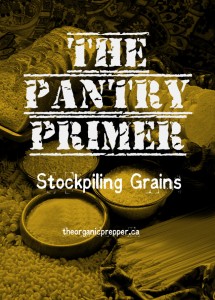
Food storage calculators recommend 300 pounds of grains per person for a one year supply. For a family of four, that is a whopping 1200 pounds of food that you should store if you are trying to build a one year pantry!
That sounds like a really daunting number until you remember that it is divided over many different items. To name a few:
- Rice
- Flour
- Wheat
- Quinoa
- Couscous
- Cornmeal
- Barley
- Oats
- Pasta
You should divide up your grain storage based upon your family’s preferences. After all, if only one person likes rice, the rest of you won’t want to be stuck having it at every other meal if you must live off your stockpile for a year!
Most grains can be purchased in very large quantities at a greatly reduced price. When purchasing in amounts over 20 pounds, your food storage methods become particularly important. When deciding what storage methods you intend to use, you must ask yourself whether you intend for these goods to be your long term food storage, remaining untouched unless disaster strikes, or whether you intend to rotate them from the pantry to the kitchen, using them and replenishing your pantry as needed. Check out this detailed information on food storage methods.
Great grains
Let’s take a closer look at these building blocks.
Rice More than 3 billion people across the world eat rice every day. Rice has long been at the top of the hierarchy in the prepper’s pantry. It’s inexpensive, a source of energy-boosting carbohydrates and can extend one humble serving of meat to turn it into a meal for an entire hungry family. Learn more about choosing the best rice for your pantry HERE.
Oats Oats can be used to add extra fiber to baked goods, in place of breadcrumbs in meatballs and meatloaf, and as a hot cereal. They are also a staple ingredient in granola, and of course, the much beloved oatmeal cookie! Oats can be purchased in bulk quantities and then repackaged for long shelf life.
Flour Very shortly after wheat is cracked open, it loses 60% of its beneficial nutrients. I do store flour, however, first as a convenience item and secondly because the addition of a small amount of commercial flour improves the texture of my homemade bread.
Wheat Wheat berries are the “real” whole wheat. Wheat berries are actually not berries at all – they are kernels of wheat. I buy hard red wheat berries. The benefits to wheat berries are numerous: They last almost indefinitely when stored properly, they are a mighty source of nutrients, vitamins, and minerals, and they can be used in a wide variety of ways. You can grind them into flour (be sure you have a hand grinder that will work off-grid). You can also cook them whole and make a yummy pilaf as a side dish or a hot breakfast cereal. Learn more about wheat HERE.
Pasta This quick and easy comfort food comes in many different shapes and sizes. Whole wheat pasta, while more nutritious, doesn’t last as long on the shelf as does white pasta, so let your planned shelf life be a determining factor in which type of noodles you choose to buy. Pasta cooks up very quickly, using little fuel, so it is a good choice as long as you have the ability to boil water. Depending on the shelf life you require, you may not need to repackage pasta to keep it fresh. This is an item that goes on sale frequently – so stock up whenever you can!
Quinoa This delicious little kernel is the highest protein grain around. Tess Pennington writes, “Quinoa (pronounced keen’-wah) is a high-protein grain that the Incas held sacred, calling it the “mother of all grains.” This ancient grain has had a recent resurgence in popularity because of its excellent nutritional profile, easy preparation and versatile nutty taste.” (source) Quinoa is more expensive than most other grains, but the high quality nutrients make it a great investment.
Cornmeal I strongly recommend seeking organic options for all things “corn” as more than 80% of corn in North America is genetically modified, making it a poor choice for your food storage pantry at a time when you need reliable nutrition.
Barley This easy to cook, very neutral grain is a high-fiber addition to soups, stews, and casseroles. It has a nutty flavor and a similar consistency to pasta. It is sold in different forms: hulled, pearled, flaked, scotch (or pot), or grits.
Please feel free to share any information from this site in part or in full, giving credit to the author and including a link to this website and the following bio.
Daisy Luther is a freelance writer and editor. Her website, The Organic Prepper, offers information on healthy prepping, including premium nutritional choices, general wellness and non-tech solutions. You can follow Daisy on Facebook and Twitter, and you can email her at daisy@theorganicprepper.ca
The original article can be found here:
https://www.theorganicprepper.ca/the-pantry-primer-stockpiling-grains-10302013